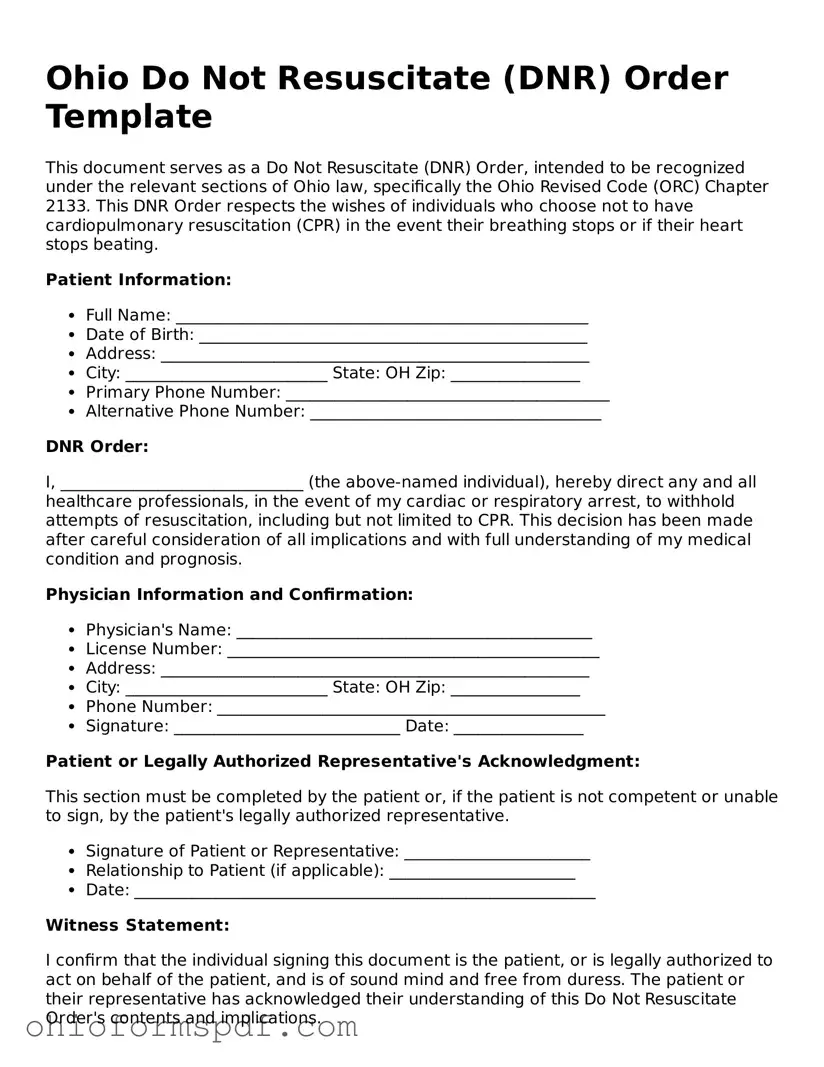The Ohio Do Not Resuscitate (DNR) Order form is similar to an Advance Directive, which allows an individual to state their wishes regarding medical treatment if they are no longer able to communicate due to illness or incapacity. Both documents are proactive measures for healthcare planning, ensuring an individual's preferences are known and respected in critical situations.
Another document that shares similarities with the Ohio DNR Order form is a Living Will. A Living Will specifically details what types of life-sustaining treatments an individual would like to refuse or accept, much like a DNR order specifies not to perform CPR in the event of cardiac or respiratory arrest. Both serve as legal guides for healthcare providers in end-of-life care situations.
The Medical Power of Attorney (POA) document is also akin to the Ohio DNR Order form. While the DNR specifically refuses certain types of emergency treatments, a Medical POA designates someone to make healthcare decisions on an individual’s behalf. Both documents contribute to ensuring a person's medical treatments align with their wishes when they're unable to communicate choices.
The POLST (Physician Orders for Life-Sustaining Treatment) form shares its purpose with the Ohio DNR Order form, as it also guides emergency medical personnel and other healthcare providers on the treatments that an individual wishes to receive or avoid near the end of life. POLST forms are more comprehensive, addressing treatments beyond resuscitation.
Healthcare Proxy forms, much like the Ohio DNR Order, allow individuals to outline specific healthcare wishes, including decisions about resuscitation. However, while a DNR directly addresses the issue of resuscitation, a Healthcare Proxy appoints another person to make healthcare decisions when the individual is unable to do so.
A Do Not Intubate (DNI) order is closely related to the DNR Order form, as it instructs healthcare providers not to perform intubation for mechanical ventilation. Both documents are used to decline specific life-sustaining procedures, focusing on the individual's autonomy over their end-of-life care.
Five Wishes is a comprehensive document that, like the Ohio DNR Order, deals with medical treatment preferences at the end of life. It covers personal, spiritual, medical, and legal aspects, including the desire not to be resuscitated, making it a broader planning tool that encompasses the principles behind a DNR.
The HIPAA Release Form, while primarily about privacy and the sharing of medical information, indirectly connects to the DNR Order form through its role in ensuring the right people have access to necessary health information. This facilitates discussions and decisions around end-of-life care, including resuscitation preferences.
An Emergency Medical Information Form contains comprehensive medical data for use in emergency situations, loosely related to the DNR Order which is a directive specifically for emergency situations. This form includes allergies, conditions, medication, and also can contain DNR wishes, making critical information quickly accessible to responders.
Last, the Organ Donor Registration forms, although not directly related to treatment preferences during life, share with the DNR a forward-thinking approach to medical decisions. While the DNR Order informs emergency healthcare providers about resuscitation wishes, organ donor forms convey wishes for after death, both being proactive steps in personal healthcare planning.
